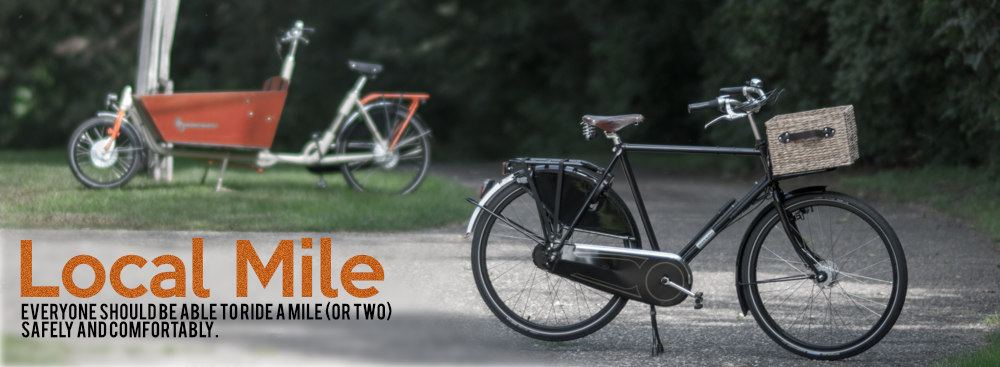————— DRAFT —————
There are several things that we’d like to know about the environment in our sauna:
- Ambient Air Temperature / Stratification – Thermometer
- Radiant Heat
- Moisture / Relative Humidity / Stratification – Hygrometer
- CO2 – CO2 Meter
- Particulate Matter – PM Meter
Table Of Contents
- TLDR – My Setup
- What’s A Good Sauna?
- Thermometers – Location
- Thermometers – Analog
- Thermometers – Digital
- Thermometers – Radiant
- Thermometers – IR
- Hygrometers – Analog
- Hygrometers – Digital
- CO2, PM and VOCs – Location & Measurement
- Professional Multi Sensor Devices (CO2, PM, etc.)
- Consumer / Home IAQ Monitors
- Electricity
- Deeper Dive
- Measurements Protocols
- DIY – Sensor-On-A-Wire
- Crowd Sourced Data
- Lab Tests
- Notes
- CO2 Accuracy
TLDR – My Setup
On The Road – The key things we want to know are accurate head temp, accurate foot temp, and CO2. For measuring saunas on the road then I typically take:
- Aranet 4 for CO2.
- Meatsticks for accurate temperature measurements. Usually 2: Head & Foot. Sometimes as many as 8 (the limit for Meatstick channels). See further down for how to hang them.
- FLIR One Pro Infrared camera for my iPhone.
These are good tools for anyone to use in evaluating a sauna. The big missing piece here is accurate humidity.
Trumpkin Test Sauna – My home sauna uses a DIY rig of 8 Temp/RH probes, 2 CO2 detectors, and 2 PM (1.0/2.5/10) detectors (Thanks Ted!). I’ve tried running this on Raspberry-Pi’s but keep running in to overheat problems so currently using a Mac Mini. This is the only way I’ve found to get accurate temp and humidity measurements.
I also have a Thermadata WiFi with 2 probes. One over the heater and one by the thermostat sensor (1m above the sitting bench) for logging the temperature over the heater relative to the sauna temp.
I also have a radiant heat sensor (temp probe bonded to a copper disk), differential pressure sensors and three anomometers for measuring airflow rates in ducts and at vents.
I will sometimes take part of the DIY setup with me to evaluate saunas on the road (mainly for accurate humidity to document steam) but this requires about 1 hr of setup prior to heating the sauna, a cool and secure place for the electronics and a MacBook Pro, a good bit of wiring (each probe requires a long fairly thick cable) and then time to disassemble and pack after the sauna has cooled down. So basically a PITA.
What’s A Good Sauna?
While someone in Finland might know sauna and know good from bad for themselves, that is not the case for many others, particularly those of us in North America. We don’t know what a good sauna is because I don’t know that we have any good saunas to compare against. If we’ve never had anything but freeze dried instant coffee we think it’s great …until we try the real fresh thing. 🙂
Objective measures can provide a way for us to better understand and evaluate saunas. To know if a sauna has the capability, similar to saunas in Finland, of good löyly. This is particularly important for anyone building multiple saunas for customers so that they can improve with each new sauna they build.
‘Feet above the stones’ for instance isn’t really a goal itself but a means to some goals. Our goals are fairly even convective heat and steam head to toes, front to back and minute to minute, and no radiant heat felt from the heater. Feet above the stones is a primary way to meet these goals. So it’s important to know what our ultimate goals are, particularly for instances where constraints prevent us from fully utilizing primary means. If we can’t have our feet high enough above the stones then perhaps a Saunum can meet our goals.
Some target values we might aim for are*:
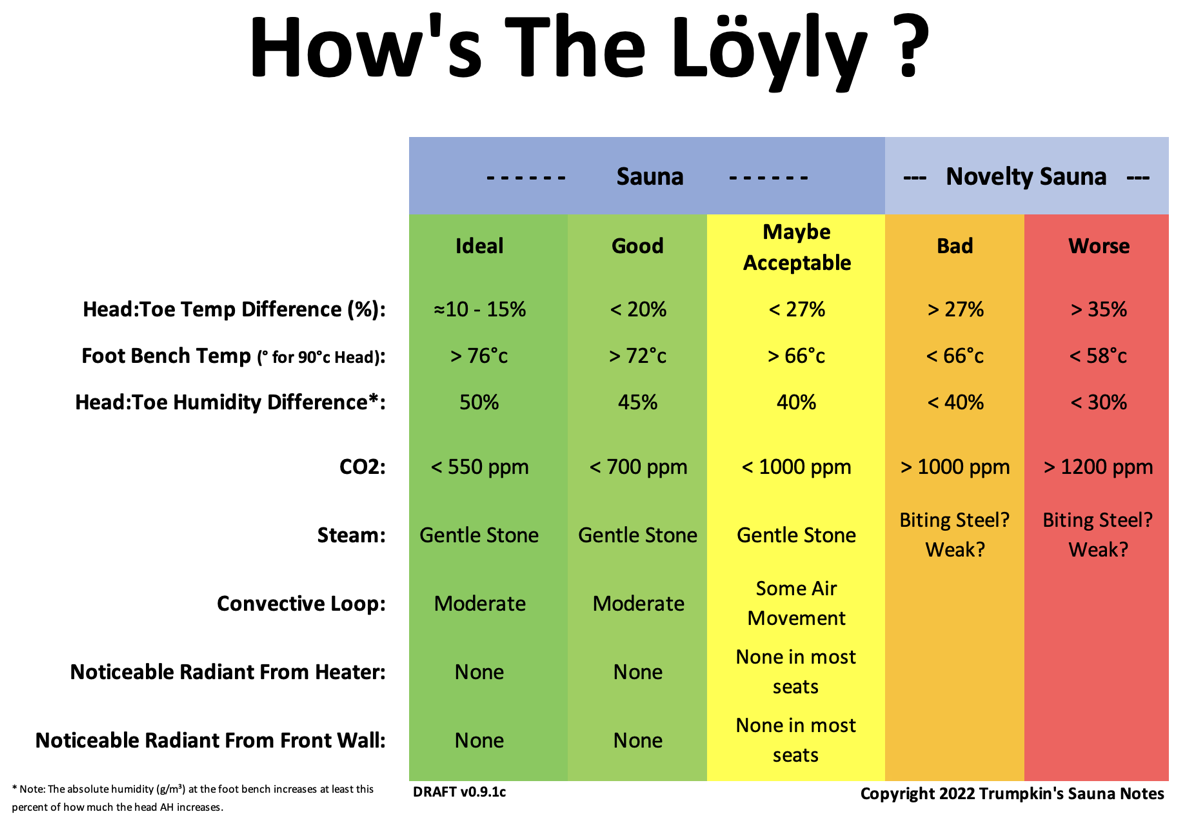
The Head to Toe Difference will for example provide an objective measure of the temperature component of ‘cold feet’. Less than about a 20°c difference isn’t usually cold feet. Greater than about a 30°c difference is cold feet. Many of us never thought we had cold feet until we experienced actually not having cold feet in Finland and realized how much better sauna could be.
This though is only a solid foundation. This can tell us if a sauna has or does not have the potential for löyly. Doing well on these but, for example, having a ceiling sloped the wrong way might still result in a poor sauna. These objective measures are NOT the be all and end all. There are still elements that can’t really be measured, only experienced.
Note: Perhaps more important than ‘the temp’ is the quality of the heat – that bathers experience as even of convective temps as possible head to toe, front to back and minute to minute without any noticeable radiant from the stove. And the quality of the environment – low CO2, steam is gentle, doesn’t linger and build up, and it’s quiet and peaceful.
Improving Everyone’s Knowledge of Sauna – A database of these data can begin to give us all an idea of how various heaters perform in various sized and shaped saunas. More below in ‘Crowd Sourced Data’.
Thermometers – Location
Temps vary throughout the sauna so where you put your thermometers matters.
Official Sauna Temperature – The generally accepted official location for ’the sauna temp’ is 1m (39”) above the upper sitting bench opposite the heater – so at the head of a bather sitting in the middle of the bench. When someone in Finland says that they like 96°c, this is what they are referring to.
Thermometers elsewhere in the sauna can tell us what the temp is at that location but that is not ‘the sauna temp’ and could be off by ± 30°c or more. However, it can be useful to know temps elsewhere. I have 4 semi permanent probes; 1) Official 1m above the middle of the upper bench, 2) At the foot bench below #1, 3) 1m above the upper bench at the far side from the heater and 4) 20cm above the heater.
Cold Layer – Note that there is a layer of colder air near walls. This layer generally seems to be about 40-70mm (1-3”) thick and can be as much as 25°c cooler. For accurate measurements probes must be placed far enough from the wall to not be affected by this. For more see the discussion of the Meat Stick under Digital Thermometers below.
Heater Thermostat Sensor – Outside of North America the thermostat sensor for electric heaters is typically placed 1m above the sitting bench (or about 20cm below the ceiling) and usually at least 20cm from any corners. This maintains a consistent and accurate sauna temperature.
Inaccuracy In North America – UL guidelines in North America complicate things and require that the thermostat sensor be placed above the heater. This location is however much hotter than elsewhere in the sauna so when this sensor says that the sauna is 190°f, it is likely only about 150°f.
It is common in North America for people to move the sensor lower on the heater wall in order to get higher temperatures than allowed by UL but this also increases the high-low ‘swing’ which is uncomfortable. Better is to place it properly on the bench wall and 1m above the sitting bench. This will provide more accurate, higher and more even temperatures in the sauna. This goes against UL guidelines however.
North American heaters also have a UL mandated High-Temp Limit Sensor in the heater that can cause unnecessary problems. I’ve a collection of photos of solutions people have tried including pulling these further from the heater if mounted on it, placing a fresh air vent as close to the sensor as possible, having a fan blowing air on to the sensor, and other not so successful or more dangerous endeavors.
Thermometers – Analog
For most people a simple analog dial wall thermometer made for a sauna will do the trick. They’re inexpensive, look good and are usually accurate enough.
Single Temp Accuracy – These are generally only accurate at one temp (and will ‘drift’ high or low the further away from that temp you are). Most are adjustable though so we adjust ours to be accurate at 100°c (212°f). We usually like our sauna to be about 90-96°c (194-204°f) and maybe once per week in the 105-115°c (221-239°f) range so we know that it’s pretty accurate for these.
To check and adjust analog thermometers the best option is to buy, beg, hire or borrow a NIST calibrated digital thermometer. A glass tube candy thermometer may work for this as well but I’d not want to keep it in there permanently as cleaning up glass shards out of soft wood from the tube breaking is nearly impossible.
Drift – We know that one of our analog thermometers looses about 1°c per 6°c diff from 100°c so we know that if we want 85°c actual that we should look for about 88°c on the thermometer.
Slow – Analog thermometers are slow responding. Your sauna may get to your preferred 94°c but your thermometer still says 83°c and will take another 10 minutes to get to 94°. It’s kind of telling you what the average temp has been over the past 20 minutes (or sometimes what it was 10 minutes ago) rather than what the current temp is.. Similarly, they also miss peaks and valleys. However, if you maintain a consistent temp then it will eventually settle in and be close enough.
Oven Thermometers – These are generally not very accurate and being off by 30°f or more is not unusual. In one test of 4 Taylor oven thermometers they were off by 13°f among themselves but ALL of them were above the actual temp as measured by a NIST calibrated digital logging thermometer with the best one 14°f high and the worst reading 27°f above actual.
Thermometers – Digital
Digital have a number of advantages including being more accurate at all temps and have a faster response time. With a good one – what you see is what you’ve got. The downside is that electronics generally don’t like the higher temps of a sauna.
One solution is a digital thermometer with external probes so that the electronics can be in a cooler location and the probes where you want them – such as 1m above the upper sitting bench, which would be too hot for electronics.
Note that metal probes can be affected by radiant heat resulting in inaccurate measurements. Radiant shields, like a piece of wood, can help. Small PTFE probes are less affected and thus tend to be more accurate.
A few of many options:
Thermoworks BlueDOT with pluggable probes – These are inexpensive and accurate. Available in round or square, various colors and with or without bluetooth (I believe you need BT for logging though). The DOT can be placed low (where temps stay below 50°c) inside the sauna or on the wall in the changing room. Air probes will be somewhat more accurate than meat probes but not significantly.
Thermoworks Thermadata WiFi or Thermadata 4-Channel Logger – These is the most accurate for the money devices we’ve found. We use the PTFE/FEP probes in saunas (though air/cooking probes work relatively well also). I’d recommend getting K-style probe loggers if accuracy is important. The logger itself sits near the floor or on the wall in the changing room and probes can be placed wherever we want. The wire for the probes is rather stiff so get only as long as you need. One 7m and a few 2m & 3m work well if you want to experiment. One drawback is that it only does automatic WiFi updates once per hour (or when the Audit button is pressed which is a bit of a problem for remote monitoring). Temps displayed on the logger itself are current and accurate however.
One benefit is that pressing the ‘start/audit’ button generates an ‘audit’ marker at that point in time and forces a cloud update via WiFi. In the graph below I did two rounds in the sauna, pressing the audit button when I entered and left the hot room each round. For the 1st round head temp was 100.7°c and foot temp was 86.5°c on entering and 97.6°c / 84.7°c leaving 11.2 minutes later. The second round was 96.9°c / 84.5°c entering and 89.6°c / 81.1°c leaving.
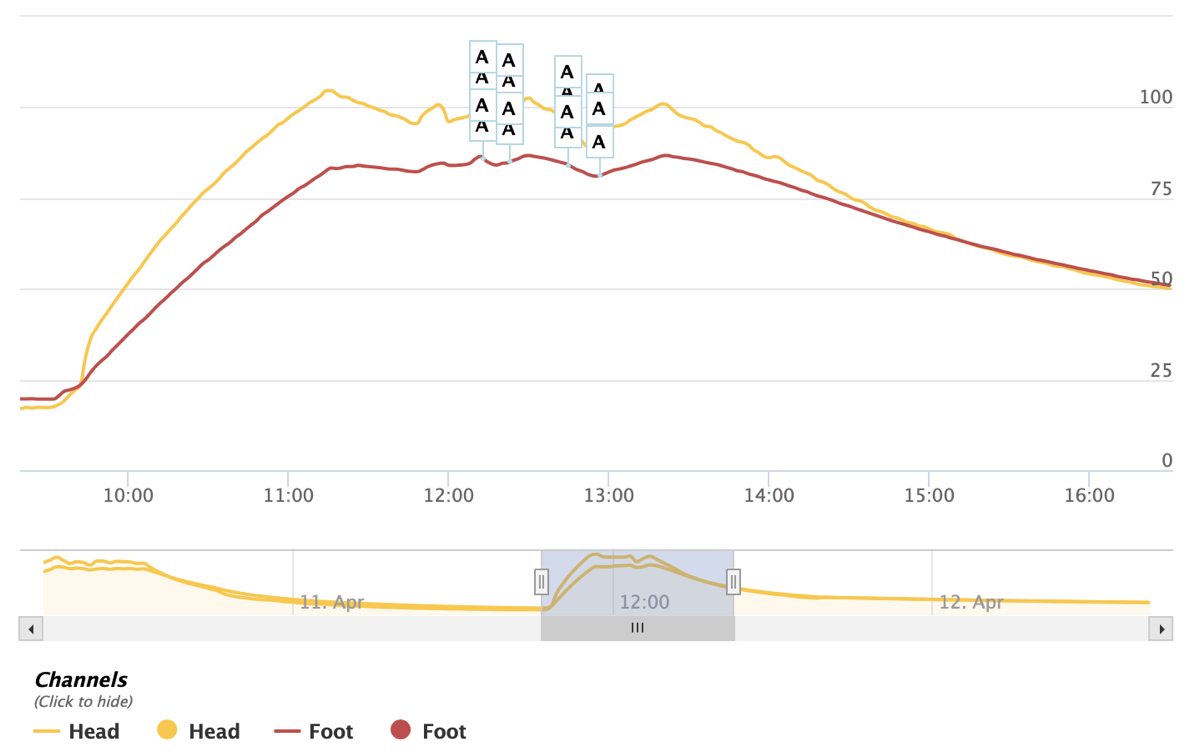
Onset HOBO 4-Channel Logger – This has two advantages over the Thermoworks 4-channel; 1) the logger is good to 70°c so can be placed higher in the sauna and in many cases on the foot bench and 2) the logger includes a thermometer so you actually get 5 channels of logging.
Meat Stick – The Meat Stick is a wireless bluetooth probe that provides relatively accurate temperature measurements and logging. This is now my go-to for travel. I’ve got four that I take with me as a way to easily get more accurate temperature measurements than my FLIR that is subject to the varying cold layer effects along walls. I made some cardboard holders that hold the tip out about 50mm from the wall and that I can easily pin or tape to the wall without damaging the wood (and that folds flat in my computer bag). The image below shows how much cooler temps at the wall (77°c) can be and that a FLIR image will show compared to the actual ambient temperature (87.8°c). These are also great for cooking, including sous vide.

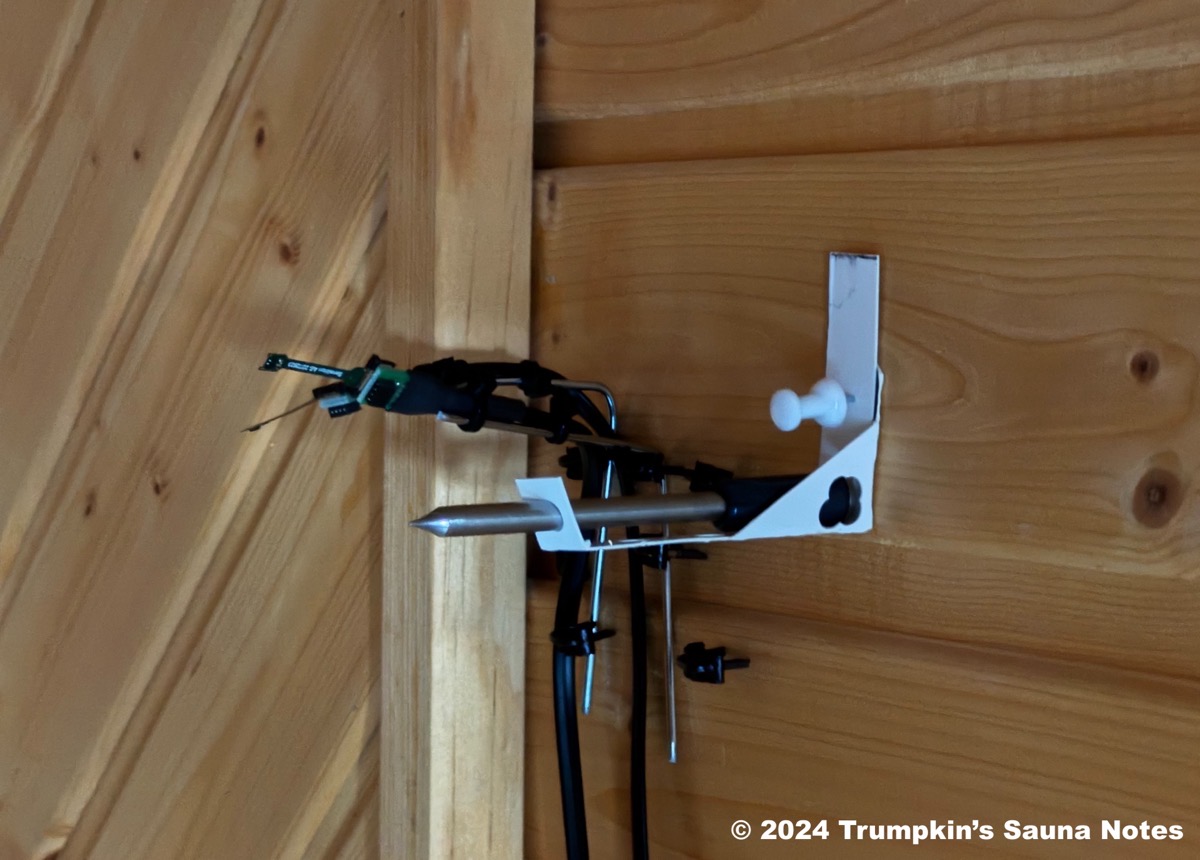
Testing Accuracy. Meat Stick in my homemade cardboard holder next to a couple of T/RH sensors on a wire. I also tested with four T/RH sensors next to each of the four sensors in the Meat Stick and found the accuracy to be within 0.4°c for each.
A simpler way to hold it. I’ll use some foil tape in place of the pin in some saunas to prevent leaving a pin hole.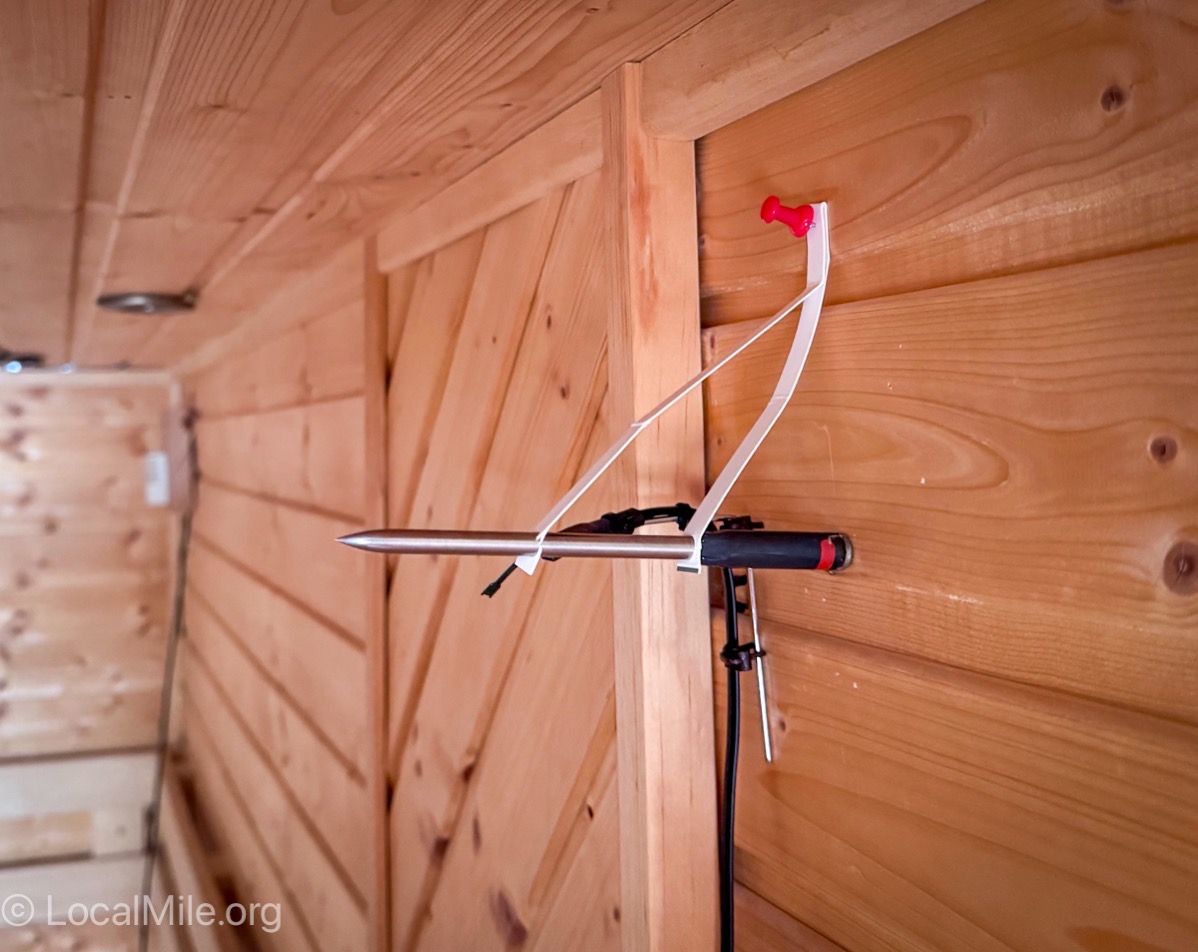
For head temp I’d recommend the Meatstick4 as the Chef and Original don’t get a sensor out far enough from the wall. A chef or original can work OK sitting vertical on the foot bench though a Meatstick4 provides a bit of more useful information on stratification.
The 4 & V are both rated for 100°c for all probes though it will give warning messages with lower temps like 95°c.
Fireboard or similar cooking loggers – These can be a good option for many people as they can more easily do multi-duty. While the food sensors can be relatively accurate, using ambient sensors for measuring ambient air temperatures is preferred. The popular ThermaQ for instance is the same device as the Thermadata WiFi, just a different interface.
One Texan with one of the better saunas in the U.S. uses a Fireboard and 5 ambient probes to analyze the stratification in his sauna. The 33°f head to toe temp difference here is quite good.
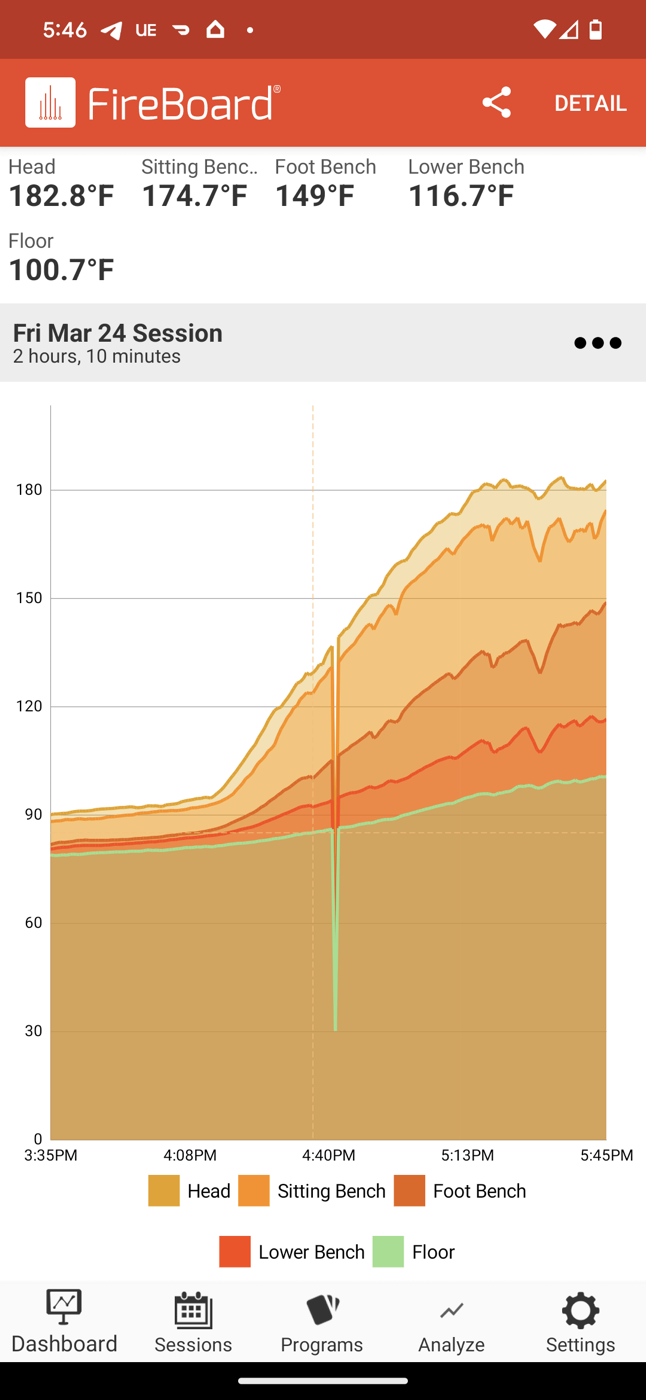
Ruuvi Tag – These have proven to be slow, inaccurate and are limited to only 70°c (or 85°c for the Pro or with a special battery). Neither can be placed at head height (you’ll have to guess what the actual temp is at head height and since it varies more than lower down this is difficult). I do not recommend these as a thermometer (they are actually the worst digital thermometer we’ve seen).
Inkbird IBS-TH1 – The device and it’s internal sensor is only good to 60°c and the external probe is only good to 100°c. The probe temp limit might be OK for some, but people should be cautious and know that once the probe has gone over temp it is no longer ‘reliable’. Accuracy is OK but not great at ±1°c. Humidity accuracy is poor at 25°c / 77°f and so presumably quite bad at sauna temps.
All-In-One Digital Probes like Thermapens, Thermopops or the myriad of these available anywhere and everywhere are not accurate when the device is above 50°c so are at best questionable in a sauna.
Thermometers – IR
IR Thermometers measure the temperature of a solid surface. They DO NOT measure or indicate accurate air temperature.
Surface temperatures can be affected by convective, conductive and radiant heat. So, an IR thermometer is not necessarily a good way to determine air temperature. However, if there is very little radiant heat from the heater then the surface temperature of a wall or bench can give us an idea of ambient air temp so long as we’ve adjusted for surface type and accounted for the cold layer.
If the heater is giving off a lot of radiant heat then the surface temperature of a bench could be much higher than the ambient air temperature however. A bench surface being 20°c (36°f) warmer than ambient air temp is not unusual. Ideally though there should be very little measurable radiant heat at the benches so the surface temp of the benches should be about the same as the ambient air temp if the sauna has been at temp for at least 30 minutes.
Walls are trickier because they not only gain heat via convection and radiation (and perhaps a tiny bit via conduction) but also loose heat via conduction to outside. Wall temperatures will almost always be somewhat colder than air temp. How much colder depends primarily on insulation and outside air temp. In most cases the difference is 10-15°c at head but I’ve seen as great as 24°c
Thermometers – IR Camera (FLIR)
These can provide an quick and rough idea of the temperatures in a sauna. It’s important to keep in mind the layer of cooler air along the walls that affects what an IR camera sees. The difference in wall temperature and ambient is generally greater near the ceiling and lessor near the floor. So when a FLIR image indicates 85°c at head level the actual ambient temps are likely 95°c or more. At foot bench level the ambient temps will be about 2-5°c higher. The image below was taken just before I’d done the Meat Stick screenshot above. The Meat Stick is located at position #2 in this image that here indicates 75.8°c. The Meat Stick indicated 77°c at at the wall and 87.8°c actual ambient (tip of the Meat Stick that was about 50mm out from the wall). So about a 12°c difference between the FLIR and actual air temp. Two Sensirion probes near the butt and tip of the Meat Stick verified the accuracy of it’s measurements.

Hygrometers (Humidity) – Analog
Analog Dial Hygrometers are inaccurate and realistically worthless. This is largely a nature of the beast thing (physics) more than any kind of manufacturing problem. Interesting to have on the wall as decoration but not really of any use.
A wet-bulb + dry-bulb (psychrometer) along with a chart to calculate humidity is fairly accurate though.
Hygrometers – Digital
Digital Hygrometers can be quite accurate but this accuracy can come with considerable cost at sauna temps. Our MAC 125 works well for measuring moisture in a sauna but costs about $3k.
Some multi-sensor devices and IAQ monitors have somewhat accurate digital hygrometers but these all need to be kept in lower temps below the Löyly pocket, its convective loop and thus the steam (image below) so are pretty much useless.
The best affordable option currently is to make one. See DIY – Sensors On A Wire above. I am hopeful that a local mfr will begin offering a T/RH package that will work well for saunas.
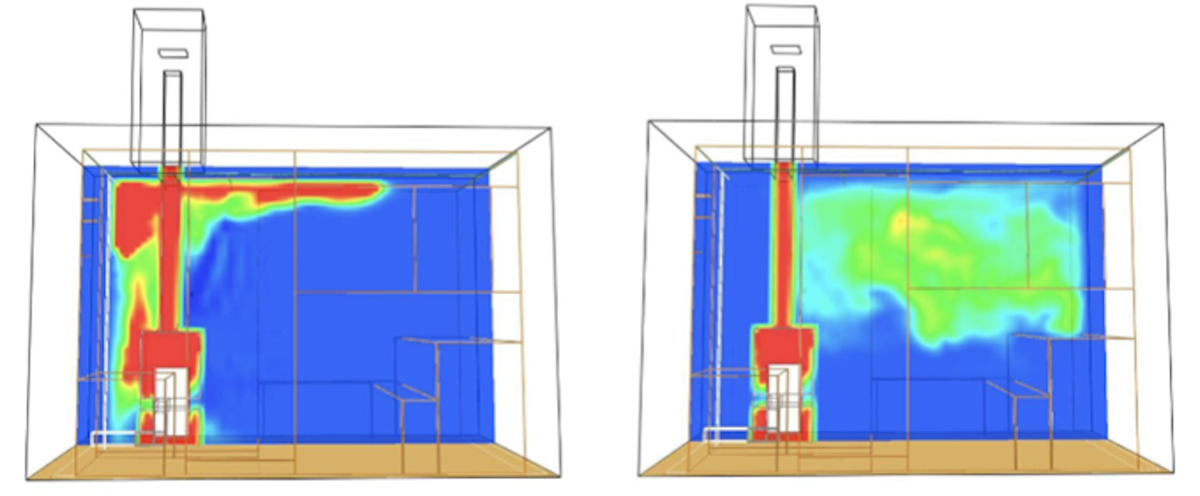 Sauna Steam. Image by Corentin Macqueron.
Sauna Steam. Image by Corentin Macqueron.
CO2, PM and VOCs – Location & Measurement
What we want to know is what the level of CO2 (and other contaminants) is that we are breathing in. We don’t much care what the levels are lower down or anywhere else. The ONLY place to accurately measure CO2 is at an imaginary bather’s face. For accurate measurements then the CO2 meter’s sensor must be placed at ≈700mm (28”) above the sitting bench and above approximately the front edge of the bench. In other words, where someone’s mouth and nose would be in a sauna.
The sensor can also be placed in the air stream between bather’s mouths and the exhaust. So just below the foot bench in a sauna with proper Mechanical Downdraft provides reasonably accurate measurements.
I have done numerous CO2 measurements in saunas and have found that CO2 in poorly ventilated saunas is less in lower parts of saunas – or more specifically that CO2 at bathers faces is much higher than measurements taken below the foot bench. My guess is that the CO2 is simply recirculating with the convective loop.
With downdraft ventilation in a well sealed sauna the CO2 levels at bathers faces appears very similar as elsewhere in the sauna, perhaps 10% higher than just below the foot bench.
In a sauna with updraft or natural convection ventilation, almost any electric heated sauna that does not utilize mechanical downdraft, measurements must be taken at bathers faces. Measurements taken lower, effectively in the draft of fresh incoming air, can be as much as 80% lower than actual. In our sauna, with natural updraft ventilation, a CO2 meter on the foot bench will indicate ≈700 ppm while actual CO2 at bathers faces can be over 5000 ppm.
Similarly if the exhaust is mistakenly placed above the foot bench (VTT’s P2 location) then measurements just below the sitting bench and that are in the air stream should be somewhat accurate, typically about 20% less, while those below the foot bench will not be accurate.
The temperature and humidity in the sauna should not exceed the rating for the measurement device but should be as high of temp as the device will allow.
For CO2 the sauna should ideally have the number of average size adult males the sauna is designed for.
For PM steam must be created by throwing water on the stones as this seems a key source of PM. However, some less expensive PM meters can have difficulty distinguishing high moisture content from actual PM. I think what’s happening is that the PM sensor (laser or IR) is seeing the increase in water particles before the digital hygrometer is measuring a change (a PM device must subtract the humidity from the PM sensor measurements in order to know what’s PM and what’s not).
Measuring For Mold – Mold is kind of more animal than plant and similar to all animals it produces CO2 and sometimes very considerable amounts of it. One way to know if you likely have a mold problem is to monitor the CO2 in the space when there are no other CO2 producers and no air movement. Changing or erratic CO2 levels, and particularly if there are spikes above about 800 ppm, indicate the likely presence of mold.
Professional Multi Sensor Devices (CO2, PM, etc.)
Most multi sensor devices include temp and humidity (and ideally barometric pressure) as these are necessary for reporting accurate CO2 measurements. Note that the device itself will not tolerate higher sauna temps so must be placed lower in the sauna. This will provide an indication of the levels of these elements for that location in the sauna but you’ll have to guesstimate/calculate for higher up where we and our breathing are in the löyly cavity.
Gaslab (CO2Meter.com) CM Series – The CM-501 and CM-505 are useful for sauna. The 501 provides accurate temp, humidity and CO2 levels while the 505 adds a number of measures including PM which is valuable. Note that these are only good to 50°c so must be placed fairly low in the sauna when the sauna is at normal temps. However, you can also experiment with heating your sauna to 50°c and placing these up higher to get an idea of humidity, CO2 and PM up higher. These measurements will not be the same as at temp measurements but can still be useful.
TSI 7585 & 7545 – These are higher quality devices that are a bit more accurate than the 501/505 but also come with higher price tags of about $2k. These also must be kept below 45°c so well below the foot bench of most saunas. These are also widely available for rent. Be careful about heat though as if the logs indicate that it’s been in too hot of an environment the warranty (own or rental) is void. FWIW, we use a lot of TSI gear and have found it to be quite exceptional (and FWIW we’ve also learned that these appear to function well up to about 75°c (though that WILL void your warranty)).
Note (Feb 2024): A small group of us is working on a few options for better measurements including a CO2 sensor that may operate at up to 85°c. More to come!
Consumer / Home IAQ Monitors:
Many home IAQ monitors can be useful in a sauna to measure humidity, CO2, Particulate Matter and other stuff. The thing to keep in mind is that they are not designed for sauna temps so must remain where temps are lower which will affect accuracy for what’s happening higher up where we are.
Many consumer devices do not accurately compensate for temperature and barometric pressure with their CO2 measurements so that’s something to watch out for. There is some valuable review information at Southcoast AQMD.
Aranet 4 – Likely the best option for CO2 measurements in a sauna. Provides Temp, Humidity, Barometric Pressure and CO2. Works up to 50°c so should be placed below the foot bench in operating saunas or the sauna heated to only 50°c for testing at head level. One advantage of these is that they are small and battery powered so easy to carry around. We’ll often take one with us to restaurants, plane trips and other things where we might be in close contact with a lot of other people. Since CO2 is a good proxy for ventilation and pathogen levels we get a good idea how risky certain situations are.
IQAir AVP – Provides Humidity, CO2, PM2.5 and other data. Device is only rated to 40°c / 104°f so must be very near the floor of the sauna but should be at least a few inches above the floor if temps will allow to avoid false measurements. I’m a big fan of these for general home and outdoor air quality monitoring and they do work relatively well in saunas.
AWAIR Element – This is a fairly accurate monitor (avoid the v1 product that had errant PM measurements though). The only temp spec they provide is “-40 to 125°C (-40 to 257°F) / ±0.2°C” which I assume is only for the internal probe itself as producing a device with electronics that can function in those temps would be extremely expensive.
Good indoor ventilation for CO2, but more importantly for pathogens such as Covid, is below 700 ppm though even as high as 1,000 ppm is likely fairly safe. Above 1,000 is increasingly risky and like many others we’ll leave anywhere with CO2 levels in excess of about 1,900 ppm.
Foobot – Avoid. Great marketing but exceptionally poor accuracy. It does not have a CO2 sensor but rather calculates CO2 from other inaccurate data.
URAD A3 – Avoid. Lots of promise, disappointing results. These have so far proven to quite inaccurate and the company does not seem willing to fix them.
Other Home AQ monitors such as AirThings may work as well.
Electricity
If you want to monitor how much your electrical sauna (or any other device in your home) is costing there are a variety of options available. The best is a system integrated in to the electrical panel by the manufacturer. While these have been around a while in Europe they are fairly new to the U.S. market but are becoming more available.
IotaWatt – We looked at a number of aftermarket options and found IotaWatt to be the best for us. It requires a little more knowledge to setup but provides more useful data and accurate data than other alternatives. There is a valuable active community of IotaWatt users and developers to help.
Deeper Dive
Measurement Protocols
The following are focused on bather experience in a sauna – what our goals are for bathers. How we get to these and other goals of a good sauna experience can be quite varied.
For Kits this should provide consumers with some accurate objective information upon which to base decisions. Tests should ideally be conducted by an independent agent to insure impartiality and consistency but measurements from the manufactures will still be helpful.
Measurement 1: Simple Head to Toes. Using two or more digital probes measure the temperature over a period of time at the head (1m (40”) above the middle of the main sitting bench) and 3cm (1”) above the middle of the foot bench. With additional probes include; 3cm (1”) above the floor (approx below sitting bench probe), 3cm (1”) above the middle of the sitting bench. Best device is a multi-channel logger but Thermoworks DOTs with probes can work well as can some other digital devices discussed further below.
Measurement 2: Simple CO2. Using an Aranet4 or similar placed approx 75cm (30”) above the sitting bench (approx chin height) and the sauna heated to 50°c (or whatever highest temp the CO2 monitor is rated for). Have the number of adults the sauna is intended for sit in the sauna with the door closed for 20 minutes, exit quickly and cool down for 20 minutes, re-enter for 20 minutes.
Short Commercial/Builder Protocol:
- Line chart of actual continuously measured ambient temperatures over a period of time at the floor, foot bench, sitting bench and 1m above the sitting bench with probe placed at least 1” from any solid surface and guarded from any direct radiant from the stove.
- Protocol:
- Warm up to 105°c or max temp.
- 30 minutes with sauna empty
- Until sauna has cooled to 1/2 max temp.
- All measurements taken simultaneously
- In a 68° room for inside units
- In shaded -7°c (20°f) outside temperature for outside units
- Optional: In shaded -25°c (-13°f) outside temperature for outside units
Full Commercial/Builder Protocol:
- Line chart of actual continuously measured temperatures over a period of time at the floor, foot bench, sitting bench and 1m above the sitting bench.
- Protocol:
- Warm up to 105°c or max temp.
- 30 minutes empty
- 2 rounds –
- All enter
- One person stays 7 minutes, one 10, the rest 13
- All enter 25 minutes after all entered for the first round
- One person stays 7 minutes, one 10, the rest 13
- Wait until sauna regains max temp and then turn off.
- Until sauna has cooled to 1/2 max temp.
- All measurements taken simultaneously
- In a 68° room for inside units
- In shaded -7°c (20°f) outside temperature for outside units
- In shaded -25°c (-13°f) outside temperature for outside units
- Line chart of CO2, temperature, % relative humidity and barometric pressure. Measured at 1m above the sitting bench over a period of time with the advertised number of adults and the sauna at 50°c.
- Warm up to 50°c or max temp. Ventilation set to ‘warm-up’.
- 30 minutes empty with ventilation in ‘use’ mode.
- 3 rounds –
- All bathers in sauna for 15 minutes
- All bathers out of sauna for 15 minutes
- Wait until sauna regains max temp
- Until sauna has cooled to 1/2 max temp.
- Accompanying video of the measurement being taken and showing how long the door was opened each time.
- Line chart of relative humidity over a period of 30 minutes in a 90°c sauna measured simultaneously at 500mm above the middle of the sitting bench and middle of the foot bench (if possible also middle of sitting bench and 1m above sitting bench). Water thrown on stones @ 10, 15 and 20 minutes. Both should rise to the same level, approx 20-35% RH, and both should then decline to the base level within about 3-4 mins. If the lower bench does not attain the same level then that’s an indication of steam not reaching down to bathers feet. If the RH does not decline back to the base level that’s an indication of poor ventilation.
- Photo showing, for the advertised number of people, that number of average size adult men sitting in the unit.
DIY – Sensor-On-A-Wire
Unfortunately, aside from temperature, we lack good ways to measure the environment in a sauna and in particular if we want accurate measurements taken from proper locations. A key reason is that we want to take measurements from the higher temp of bathers heads but sensors are often combined with electronics that cannot handle the heat of a sauna so must be placed down lower in the sauna instead of where we want to measure.
Sensirion and others make several sensors that can accurately measure temp & humidity in temps up to 140°c. These can be placed on the end of a wire with the logger electronics placed lower in the sauna. Similarly, there are CO2, PM and various VOC sensors that can operate at temps up to about 50-90°c and can likewise be on the end of a wire. I believe some of these can be used with typical temperature loggers along with some corrections to the resulting data.
A better option is to use an Arduino + Raspberry Pi as the controller and logger (thanks Ted!) with sensors on a wire which is what I’m currently doing.
Ideally someone will come out with a commercially available product for this (like 6 temp+RH sensors, 2 CO2 sensors, 1 PM and 1 VOC would be nice) or maybe even a pseudo commercial product sold from their home.
Crowd Sourced Data
Obtaining data from sauna builders and enthusiasts can be a great way to build a knowledgebase of how various sauna designs and heaters perform. This would be of benefit to sauna designers, builders and heater manufacturers.
It might be possible for the organizations in each country, such as the North American Sauna Association, to have a measurement kit available for rent by members that includes a 4-probe or 8-probe temperature logger, globe probe, and devices for measuring Humidity, CO2, and PM.
While the measurements above would be very valuable, even more valuable might be more granular/precise measurements such as logging temps (and humidity) every 10cm from floor to ceiling and every second or three seconds rather than every minute. This would provide more accurate information on the depth of the löyly cavity for instance or how well a ventilation system does with removing steam.
Lab Tests
We have surprisingly little objective information on saunas. We do not know for instance how various heaters perform in various sized and shaped saunas. Nor really even how these various sized and shaped saunas perform. Lassi pointed out that while the concept of ‘feet above the stones’ sounds good, we don’t have measurements to know how important it really is. And this gets more complicated with open sided mesh heaters.
Note: As we learn more about how saunas perform we may find that some of the following measurements are not very critical.
Space Stratification – How does ceiling height, room shape or room volume effect temperatures and humidity at various strata? And at various locations within a sauna? How does heater placement within the space affect things?
Heater Stratification – To test how a subject heater performs. Simultaneous temperature and humidity measurements taken every 10cm from floor to ceiling. Ideally at various points in the sauna.
Airflow – More accurate information on airflow volume, speed and direction in various parts of a sauna could be beneficial in future space and ventilation designs.
Notes
CO2 Accuracy
An NDIR CO2 sensor counts the number of CO2 particles in a measured sample of air and from this is able to determine the number of CO2 particles per million air particles. The trick is knowing the number of air particles in the sample as that varies by temperature and barometric pressure. If these are not accurately measured and used to calculate the correct number of air particles then the denominator in our calculation is off which throws the entire measurement off.
Here’s an example. This is from a URAD A3 in our sauna.
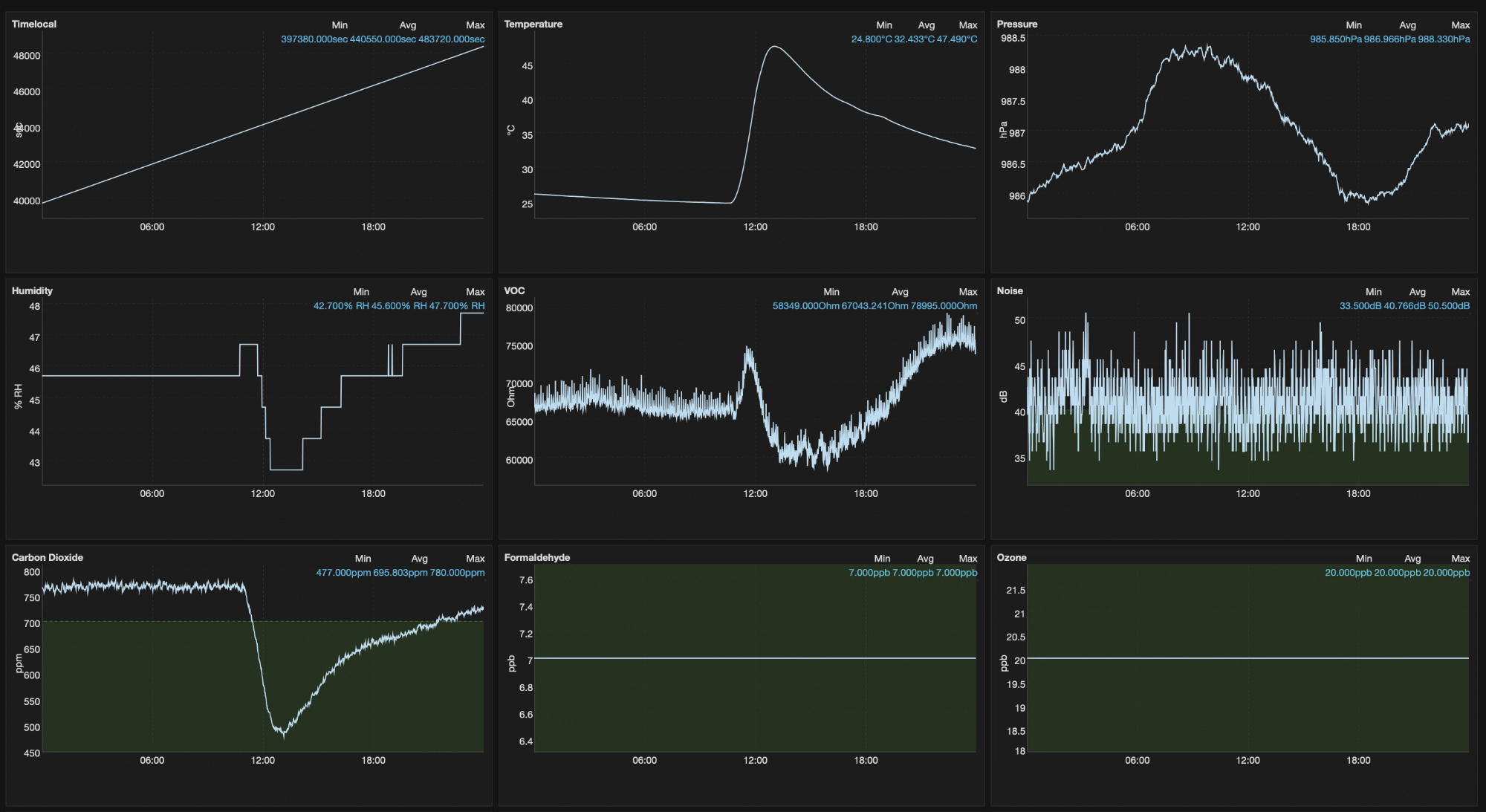
The A3, a Gaslab 501 and an IQAir AVP (along with other instruments) were on a shelf below our foot bench that does not get above 50°c. Note above the charts for CO2 and Temperature. This was in a closed sauna that had not had any humans in it for at least 24 hrs nor during the test. The first thing to note is that the 501 and AVP, which are checked against a TSI 7545 for accuracy, both showed a CO2 level of about 410 throughout this test.
During the first part of the test the URAD A3 indicated CO2 levels above 700 ppm, much higher than actual. When the sauna began heating up the URAD A3 indicated declining CO2, exactly what would be expected as raw uncompensated data from the sensor. As the sauna cooled the A3 indicated increasing CO2 levels which is what would be expected from an uncompensated raw measurement.
The most disappointing bit of this is that the manufacturer refused to correct it even after saying that they would and after we paid to ship it back to them.
The moral of the story is to be careful what you believe in marketing literature. While consumer products like the IQAir AVP have proven fairly accurate and reliable, many others like those from URAD and Foobot have proven extremely inaccurate.
——-
* Notes: After four years of refinement, this version, 0.9.1, seems to be fairly solid for what people in Finland expect. I’ll be in Finland in Spring 2025 for some additional measurements after which I hope to be able to remove DRAFT from this chart. Radiant needs some work as it is likely that measured radiant should be well below ambient in most cases to be at an acceptable or good level by Finnish standards and so must be measured during warm-up. For now I’m sticking with a sensory feel of no noticeable radiant.
Ideal here (< 13%) may not be ideal for everyone, while nobody wants cold feet, some people may also prefer to not have a very hot foot bench so some people’s ideal might be 18% head to toe difference rather than < 13%. Sometimes there can be too much of a good thing 🙂
Old discussion from Notes on Building…
Analog Thermometers – Many people say that accuracy is not important and you need a thermometer only for your own relative level. I don’t disagree with that and if you are the only one using your sauna and your thermometer works for you then that’s good enough. If you often have guests though, it’s good to have accurate temperature readings so that if you know that you are setting up your sauna to the temps they like. And for the data junkies among us… 🙂
Digital Thermometers – The most accurate temp measurement will be a NIST calibrated digital thermometer with K style temp probes. A Thermadata 2 channel logger with FEP probes is about the least expensive option I’m aware of. Remember that the logger must be kept in the lower and cooler part of the sauna. I keep one or two loggers in our sauna almost all of the time for data collection.
Hygrometers – Analog hygrometers are well known for being quite inaccurate. A digital hygrometer with appropriate tubes and pumps to accurately measure moisture in a sauna is expensive.
